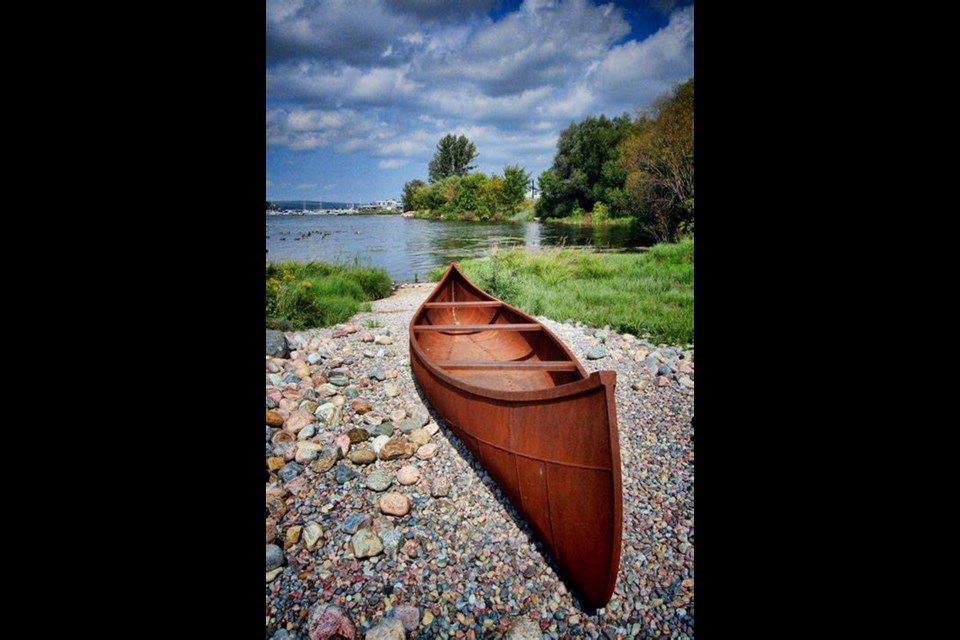In the history of Penetanguishene, there is a legend of an iron canoe.
The pattern having been set by a native, Taw-ga-wah-ne-gha, and crafted by tinsmith Toussaint Boucher who would create a canoe out of sheet metal. They dubbed it, "iron canoe.”
So taking inspiration from the birchbark canoe, the strong, light, yet flimsy conveyance used for centuries by the Aboriginal population, they endeavoued to create one out of iron? Well not just any kind of iron, Russian iron it was called.
Russian iron refers to a type of sheet iron produced in Russia during the 19th and early 20th century. This iron sheeting had a smooth, glossy black surface coating, sometimes greenish-tinged, which did not flake upon bending and made the sheets highly resistant to rusting.
As well as its corrosion resistance, the finish would also withstand high heat; these two properties accounted for most of its uses.
Kodak used it around 1906 for the manufacture of their photographic enlargers. These properties led to it being the standard for manufacturing gold pans at the turn of the 20th century.
When AC Osborne writes about Russian iron, he mentions it rather cavalierly, as we all know what Russian iron is, right? Well at that time, it was probably fairly well known. Russian iron was still fairly well used, particularly in steam engines.
But now we have no idea what Russian iron is, well until now.
Not having seen Russian iron, I would imagine much hammering would have to be done in order to make an iron canoe.
Iron isn't your normal boat-building material. It is heavy and rides low in the water. This was noted that the iron canoe wasn’t good in foul weather, slicing through the waves and taking on water.
This, however, didn't stop them from travelling far and wide with the iron canoe. The iron canoe, as legends often do, has varying dimensions.
Although said to be a God-like vehicle of 40 feet, it was evidently 24 feet at the most and could carry 20 barrels.
Toussaint Boucher was a tinsmith, but the canoe was made of iron, not tin. But not any iron, a special sheet iron made exclusively in Russia, which was also known as stove iron or planished iron.
This sheet metal was used in stoves and to clad boilers, particularly on locomotives. The process of making this iron involved putting charcoal on the sheets during the process and creating an oxidation, which turned the iron a dark colour. This made the iron less prone to corrosion.
Some have suggested it was tin, but in one line it is described as slicing through the waves and not bounding over them like the birchbark.
I think that tin would be less likely to slice through than the heavier Russian iron. Another reference has them needing wagons to portage the boat. This would also suggest a heavier boat.
AC Osborne in his original work has a footnote that says Russian iron, and I think that those at that time would have known it as such. The question is was there any other boat ever made of this iron in the world?
The iron canoe was a conveyance stuck in the middle of time, after the days of old where manpower-propelled boats, and when it would soon be replaced by steamboats. Still the people of Penetanguishene used it to go far and wide on the Great Lakes, being employed on pleasure tours with Mrs. Anna Jamieson.
In 1842, Lord Marpeth, Earl of Carlisle, and a retinue of officers and gentlemen took the iron canoe, along with other canoes of the birchbark variety, into the Great Lakes to distribute the annual presents to their native allies.
Lewis Solomon went along and they travelled hundreds if not thousands of kilometers in the iron canoe, in a time when steamboats had begun to dot the lakes.
Lewis Solomon in his narrative in Drummond Island voyageurs to Penetang by AC Osborne: "Accompanied by my father as interpreter, myself and fifty-six French voyageurs from Penetanguishene. Two of the birch-bark canoes were about twenty feet long, while the iron canoe and one bark canoe were of equal length.
“Each canoe had its complement of paddlers and passengers in addition to provisions and supplies. On arriving at Manitoulin we held a grand "pow-wow" with the Indians and distributed the annual presents, after which the party started for the North Shore (having previously visited the Hudson's Bay Co.'s post at French River), Killarney, and other points onward to the Sault.
“While at the "Sault," Lord Morpeth, Lord Lennox and party stopped at the big stone mansion built by Charles Ermatinger a long time ago. From the "Sault," we started for Detroit, calling at Drummond Island, Mackinaw, Bay City, Saginaw, Sable River, Sarnia and other points on the way. I was attendant on Lord Morpeth and Lord Lennox."
This trip alone was approximately 1,500 kilometres. An incredible accomplishment in one year.
The hearty group accomplished this for no other reason but to see the sights and distribute the "presents" or more accurately pay the price of continued alliance with the first peoples of the Great Lakes.
So Penetanguishene seems to have been the home of a very unique type of boat. One whose remains are but a ghost...Irony is that when the above canoe was commissioned, no knowledge of any prior iron canoe was thought to be imagined.
Perhaps, the spirits let them know in their way, or maybe it was the pipesmoke.
Art Duval Pipesmoke of the Past

.png;w=80;h=120;mode=crop)
